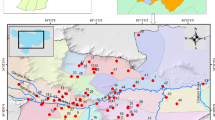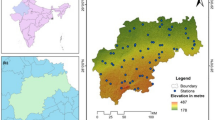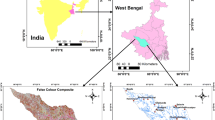Abstract
Groundwater drought is a relatively new concept, particularly in the Indian subcontinent, where groundwater levels are declining rapidly. The present study focuses on understanding the trends in groundwater levels and evaluates regional groundwater drought characteristics in the drought-prone Ghataprabha river basin, India. Cluster analysis was performed on the long-term monthly groundwater levels to classify the wells, and the Mann–Kendall test was accomplished to investigate the annual and seasonal groundwater-level trends. Standardized Groundwater level Index (SGI) was used to evaluate groundwater drought. Significant decreasing trends were observed in more than 61% of the wells in the study area with average decline of 0.21 m. Results of the SGI analysis showed that the wells of clusters 1 and 2 experienced recurrent droughts, which can be attributed to diminishing rainfall and over-exploitation of groundwater resources. The outcome of this study provides valuable information about the long-term behavior of regional groundwater levels which, in turn, helps to establish an operative groundwater management strategy for upcoming droughts.







Similar content being viewed by others
References
American Meteorological Society (AMS). (2004). Statement on meteorological drought. Bulletin American Meteorological Society, 85, 771–773.
Barik, B., Ghosh, S., Sahana, A. S., Pathak, A., & Sekhar, M. (2017). Water–food–energy nexus with changing agricultural scenarios in India during recent decades. Hydrology and Earth System Sciences, 21(6), 3041–3060.
Bayazit, M., & Önöz, B. (2007). To prewhiten or not to prewhiten in trend analysis? Hydrological Sciences Journal, 52(4), 611–624.
Bhuiyan, C., Singh, R. P., & Kogan, F. N. (2006). Monitoring drought dynamics in the Aravalli region (India) using different indices based on ground and remote sensing data. International Journal of Applied Earth Observation and Geoinformation, 8, 289–302.
Bloomfield, J. P., & Marchant, B. P. (2013). Analysis of groundwater drought building on the standardised precipitation index approach. Hydrology and Earth System Sciences, 17(2), 4769–4787.
Bloomfield, J. P., Marchant, B. P., Bricker, S. H., & Morgan, R. B. (2015). Regional analysis of groundwater droughts using hydrograph classification. Hydrology and Earth System Sciences, 19, 4327–4344.
Castle, S. L., Thomas, B. F., Reager, J. T., Rodell, M., Swenson, S. C., & Famiglietti, J. S. (2014). Groundwater depletion during drought threatens future water security of the Colorado River Basin. Geophysical Research Letters, 41(16), 5904–5911.
CGWB. (2011). CGWB report. Groundwater year book—India 2010–11. Ministry of Water Resources, Govt. of India. Retrieved Nov 15, 2017, from http://cgwb.gov.in/Ann-Reports.html.
CGWB. (2012). Aquifer system of India. CGWB report. Ministry of Water Resources, Govt. of India. Retrieved Nov 15, 2017, from http://cgwb.gov.in/AQM/.
Dhar, A., Sahoo, S., Dey, S., & Sahoo, M. (2014). Evaluation of recharge and groundwater dynamics of a shallow alluvial aquifer in Central Ganga Basin, Kanpur (India). Natural Resources Research, 23(4), 409–422.
Eltahir, E. A. B., & Yeh, P. J. F. (1999). On the asymmetric response of aquifer water level to floods and droughts in Illinois. Water Resources Research, 35(4), 1199–1217.
Famiglietti, J. S., & Rodell, M. (2013). Water in the balance. Science, 340(6138), 1300–1301.
FAO. (2008). A MASSCOTE case study in KARNATAKA—INDIA. Modernization strategy for irrigation management (working document-14/03/08). Retrieved Nov 18, 2017, from http://www.fao.org/3/a-bc049e.pdf.
Ganapuram, S., Nagarajan, R., & Chandra Sekhar, G. (2016). Identification of groundwater drought prone zones in Pedda vagu and Ookachetti vagu watersheds, tributaries of the Krishna River, India. Geocarto International, 31(4), 385–407.
Ganapuram, S., Nagarajan, R., & Sekhar, G. C. (2015). Identification of groundwater drought prone zones in Pedda vagu and Ookachetti vagu watersheds, tributaries of the Krishna River, India. Geocarto International, 31(4), 385–407.
Ganguli, P., & Reddy, M. J. (2014). Evaluation of trends and multivariate frequency analysis of droughts in three meteorological subdivisions of Western India. International Journal of Climatology, 34(3), 911–928.
Ghosh, S., & Srinivasan, K. (2016). Analysis of spatio-temporal characteristics and regional frequency of droughts in the southern peninsula of India. Water Resources Management, 30, 3879–3898.
Gleeson, T., Wada, Y., Bierkens, M. F., & Van Beek, L. P. (2012). Water balance of global aquifers revealed by groundwater footprint. Nature, 488(7410), 197–200.
Goodarzi, M., Abedi-koupai, J., Heidarpour, M., & Safavi, H. R. (2016). Development of a New Drought Index for groundwater and its application in sustainable groundwater extraction. Journal of Water Resources Planning and Management, 142(9), 1–12.
Güner Bacanli, Ü. (2017). Trend analysis of precipitation and drought in the Aegean region, Turkey. Meteorological Applications, 24, 239–249.
Hamed, K. H., & Ramachandra Rao, A. (1998). A modified Mann–Kendall trend test for autocorrelated data. Journal of Hydrology, 204(1–4), 182–196.
Hughes, J. D., Petrone, K. C., & Silberstein, R. P. (2012). Drought, groundwater storage and stream flow decline in southwestern Australia. Geophysical Research Letters, 39(3), L03408.
Jain, S. K., & Kumar, V. (2012). Trend analysis of rainfall and temperature data for India. Current Science, 102, 37–49.
Kendall, M. G. (1975). Rank correlation methods. London: Griffin.
KSAPCC. (2011). Karnataka climate change action plan. Bangalore climate change initiative—Karnataka (BCCI-K). Retrieved Nov 18, 2017, from http://www.lse.ac.uk/asiaResearchCentre/_files/KarnatakaCCactionPlanFinal.pdf.
Kumar, R., Musuuza, J. L., Loon, A. F. Van, Teuling, A. J., Barthel, R., Broek, J. Ten, et al. (2016). Multiscale evaluation of the Standardized Precipitation Index as a groundwater drought indicator. Hydrology and Earth System Sciences, 20, 1117–1131.
Le Brocque, A. F., Kath, J., & Reardon-Smith, K. (2018). Chronic groundwater decline: A multi-decadal analysis of groundwater trends under extreme climate cycles. Journal of Hydrology, 561, 976–986.
Mann, H. B. (1945). Nonparametric tests against trend. Econometrica, 13, 245–259.
Marsh, T. J., Monkhouse, R. A., Arnell, N. W., Lees, M. L., & Reynard, N. S. (1994). The 1988–92 drought. Wallingford: Institute of Hydrology.
Mendicino, G., Senatore, A., & Versace, P. (2008). A Groundwater Resource Index (GRI) for drought monitoring and forecasting in a Mediterranean climate. Journal of Hydrology (Amsterdam, Neth.), 357(3–4), 282–302.
Ministry of Agriculture. (2009). Drought management strategies—2009. Retrieved Nov 18, 2017, from http://nrega.nic.in/DroughtStratDraft.pdf.
Mishra, A. K., & Singh, V. P. (2010). A review of drought concepts. Journal of Hydrology, 391(1–2), 202–216.
Mishra, S. S., & Nagarajan, R. (2013). Hydrological drought assessment in Tel river basin using standardized water level index (SWI) and GIS based interpolation techniques. International Journal of Conceptions on Mechanical and Civil Engineering, 1(1), 2–5.
Motlagh, M. S., & Ghasemieh, H. (2016). Identification and analysis of drought propagation of groundwater during past and future periods. Water Resources Management. https://doi.org/10.1007/s11269-016-1513-5.
Murtagh, F. (2000). Multivariate data analysis software and resources. Retrieved July 30, 2017, from http://www.classification-society.org/csna/mda-sw.
Murtagh, F., & Legendre, P. (2014). Ward’s hierarchical agglomerative clustering method: Which algorithms implement Ward’s criterion? Journal of Classification, 31, 274–295.
Mussá, F. E. F., Zhou, Y., Maskey, S., Masih, I., & Uhlenbrook, S. (2015). Groundwater as an emergency source for drought mitigation in the Crocodile River catchment, South Africa. Hydrology and Earth System Sciences, 19, 1093–1106.
Nagaraju, A., Sharifi, Z., & Balaji, E. (2016). Statistical and analytical evaluation of groundwater quality of Tirupati area, Chittoor District, Andhra Pradesh, South India. Journal of the Geological Society of India, 88, 222–234.
Panda, D. K., Mishra, A., & Kumar, A. (2012). Quantification of trends in groundwater levels of Gujarat in Western India. Hydrological Sciences Journal, 57, 1323–1336.
Patle, G. T., Singh, D. K., Sarangi, A., Rai, A., Khanna, M., & Sahoo, R. N. (2015). Time series analysis of groundwater levels and projection of future trend. Journal Geological Society of India, 85, 232–242.
Peters, E., Van Lanen, H. A. J., Bradford, R. B., Cruces de Abia, J., & Martinez Cortina, L. (2001). Droughts derived from groundwater heads and groundwater discharge. In Assessment of the regional impact of droughts in Europe. Final report to the European Union. Institute of Hydrology, University of Freiburg, pp. 35–39.
Peters, E., Van Lanen, H. A. J., Torfs, P. J. J. F., & Bier, G. (2005). Drought in groundwater: Drought distribution and performance indicators. Journal of Hydrology, 306, 302–317.
R Core Team. (2013). R: A language and environment for statistical computing. R foundation for statistical computing, Vienna, Austria. Retrieved July 30, 2017, from http://www.R-project.org/.
Rahman, A. T. M. S., Jahan, C. S., Mazumder, Q. H., & Hosono, T. (2017). Drought analysis and its implication in sustainable water resource management in Barind area, Bangladesh. Journal of the Geological Society of India, 89, 47–56.
Rodell, M., Velicogna, I., & Famiglietti, J. S. (2009). Satellite-based estimates of groundwater depletion in India. Nature, 460, 999–1002.
Sen, P. K. (1968). Estimates of the regression coefficient based on Kendall’s tau. Journal of the American Statistical Association, 63, 1379–1389.
Shahid, S., & Hazarika, M. K. (2010). Groundwater drought in the northwestern districts of Bangladesh. Water Resources Management, 24, 1989–2006.
Shiau, J., & Lin, J. (2015). Clustering quantile regression-based drought trends in Taiwan. Water Resources Management. https://doi.org/10.1007/s11269-015-1210-9.
Siebert, S., Burke, J., Faures, J. M., Frenken, K., Hoogeveen, J., Döll, P., et al. (2010). Groundwater use for irrigation: A global inventory. Hydrology and Earth System Sciences, 14(10), 1863–1880.
Simon, T. P., & Morris, C. C. (2014). Associated use attainment response between multiple aquatic assemblage indicators for evaluating catchment, habitat, water quality, and contaminants. Journal of Ecosystems. https://doi.org/10.1155/2014/893795.
Singh, O., & Kasana, A. (2017). GIS-Based spatial and temporal investigation of groundwater level fluctuations under rice–wheat ecosystem over Haryana. Journal of the Geological Society of India, 89, 554–562.
Subbarao, N., Srinivas Rao, K. V., & Deva Varma, D. (2013). Spatial variations of groundwater vulnerability using cluster analysis. Journal of the Geological Society of India, 81(2013), 685–697.
Tabari, H., Abghari, H., & Hosseinzadeh Talaee, P. (2012). Temporal trends and spatial characteristics of drought and rainfall in arid and semi-arid regions of Iran. Hydrological Processes, 26(22), 3351–3361.
Tallaksen, L. M., Hisdal, H., & Van Lanen, H. A. J. (2006). Propagation of drought in a groundwater fed catchment, the Pang in the UK. In S. Demuth, A. Gustard, E. Planos, F. Scatena & E. Servat (Eds.), Climate variability and change—hydrological impacts, Proceedings of the 5th FRIEND World Conference, Havana, Cuba (Vol. 308, pp. 128–133). Wallingford: International Association of Hydrological Sciences Press.
Thakur, G. S., & Thomas, T. (2011). Analysis of groundwater levels for detection of trend in Sagar district, Madhya Pradesh. Journal of the Geological Society of India, 77, 303–308.
Thomas, B. F., Famiglietti, J. S., Landerer, F. W., Wiese, D. N., Molotch, N. P., & Argus, D. F. (2017). GRACE groundwater drought index: Evaluation of California Central Valley groundwater drought. Remote Sensing of Environment, 198, 384–392.
Thomas, T., Jaiswal R.K., Galkate, R., Nayak, P.C., & Ghosh, N.C. (2016). Drought indicators-based integrated assessment of drought vulnerability: a case study of Bundelkhand droughts in central India. Natural Hazards, 81.
Tibshirani, R., Walther, G., & Hastie, T. (2001). Estimating the number of clusters in a data set via the gap statistic. Journal of the Royal Statistical Society: Series B, 63(2), 411–423.
Tiwari, V. M., Wahr, J., & Swenson, S. (2009). Dwindling groundwater resources in northern India, from satellite gravity observations. Geophysical Research Letters, 36, L18401.
Van Lanen, H. A. J., & Peters, E. (2000). Definition, effects and assessment of groundwater droughts. In J. V. Vogt & F. Somma (Eds.), Drought and drought mitigation in Europe (pp. 49–61). Dordrecht: Kluwer Academic Publishers.
Van Lanen, H. A. J., Wanders, N., Tallaksen, L. M., & Van Loon, A. F. (2013). Hydrological drought across the world: Impact of climate and physical catchment structure. Hydrology and Earth System Sciences, 17(5), 1715–1732.
Van Loon, A. F., & Rohini Kumar, V. M. (2017). Testing the use of standardised indices and GRACE satellite data to estimate the European 2015 groundwater drought in near-real time. Hydrology and Earth System Sciences, 21, 1947–1971.
Ward, J. H. (1963). Hierarchical grouping to optimize an objective function. Journal of the American Statistical Association, 58, 236–244.
Wu, H., Soh, L. K., Samal, A., & Chen, X. H. (2008). Trend analysis of streamflow drought events in Nebraska. Water Resources Management, 22, 145–164.
Yerel, S., & Ankara, H. (2007). Application of multivariate statistical techniques in the assessment of water quality in Sakarya River. Turkey: Journal geological society of India.
Zakhem, B. A., & Katta, B. (2017). Overexploitation and cumulative drought trend effect on Ras El Ain karstic spring discharge (Khabour Sub-basin, Syria). Journal of Earth System Science, 126, 93.
Acknowledgments
The authors would like to express their gratitude to the Senior Geologists, Department of Mines and Geology of Belgaum, Vijayapura and Bagalkot Districts of Karnataka State, India, for providing long-term monthly groundwater-level data for the study.
Author information
Authors and Affiliations
Corresponding author
Rights and permissions
About this article
Cite this article
Pathak, A.A., Dodamani, B.M. Trend Analysis of Groundwater Levels and Assessment of Regional Groundwater Drought: Ghataprabha River Basin, India. Nat Resour Res 28, 631–643 (2019). https://doi.org/10.1007/s11053-018-9417-0
Received:
Accepted:
Published:
Issue Date:
DOI: https://doi.org/10.1007/s11053-018-9417-0




